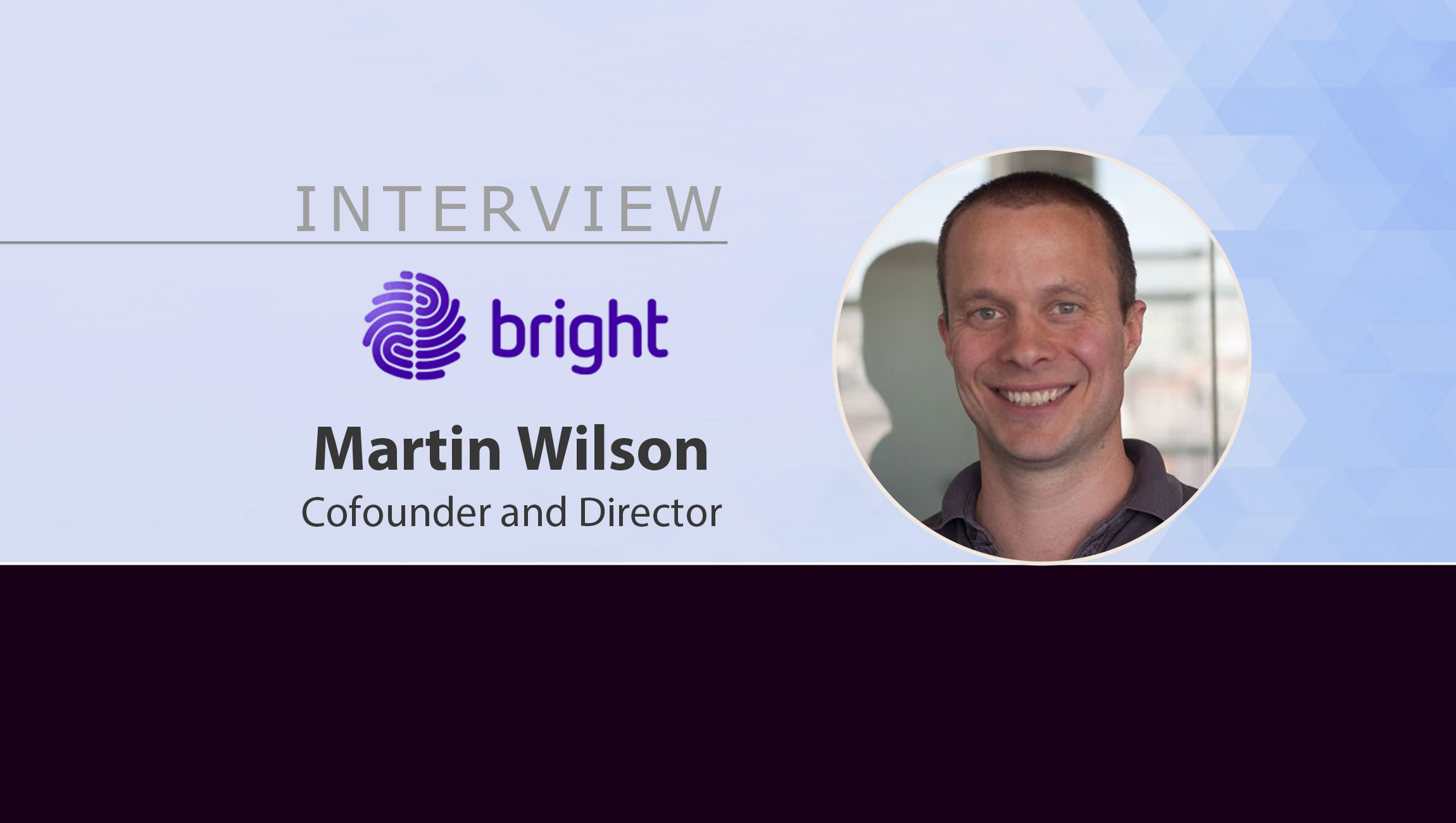Martin Wilson, Co-founder and Director at Bright shares more about the importance of visual content while talking about Bright’s growth journey:
______
Welcome to this MarTech Series chat Martin. We’d love to hear about more about Bright and what inspired you to start the business?
Our marketing team will tell you that my business partner Eric and I started Bright as we wanted to bring high-quality, reasonably priced software solutions to the world of business.
That’s all true. However, I think the main reason I wanted to start a business of my own is that I don’t like being told what to do. In particular I don’t like being told what to do by someone just because they are higher up in a hierarchy than I am.
These slightly anarchistic tendencies have made their way into our governance system at Bright. We do have a hierarchy, but it’s of teams rather than job titles. We believe that teams should be as autonomous as possible as this leads to increased motivation and better results. Team leaders have the authority to set the priorities and the outcomes they want from the team but not to micromanage.
Bright started as a software consultancy – developing software on a project-by-project basis for other businesses – but we quickly saw a gap in the market for a Digital Asset Management (DAM) solution that didn’t cost the earth, so we launched Asset Bank in 2005.
We have been implementing DAM solutions ever since, whether that’s for well-known brands such as LinkedIn, or not-for-profits including WaterAid and Amnesty International.
Our newest DAM solution, Dash, is opening up high-quality digital asset management to smaller teams and SME/SMBs who, until recently, have had to make do with Google Drive or Dropbox.
For all our history, from our consultancy roots to Asset Bank and Dash, solving problems for customers has always been at the heart of what we do
Marketing Technology News: MarTech Interview with Jordan Glazier, CEO at Wildfire Systems
Can you share a few learnings from establishing and growing Bright over the years?
Every founder who has grown a company will have a long list of things they should have done differently. These are the main lessons I learned over the years:
- Never stop learning. Listen to podcasts, read voraciously, pay attention to people who know more than you do. After achieving a certain level of success, it can be easy to think you know it all – but business is constantly changing and you need to change with it; being open-minded and willing to learn is key to that.
- It’s easy to get caught up in the day-to-day instead of spending time thinking strategically. It’s the old adage of remembering to spend time working on the business, not just in the business.
- Don’t underestimate the importance of marketing. Eric and I both have tech backgrounds, and for years our goal was just to build fantastic software. We thought that would be enough, which in lots of ways it was – it’s definitely a great start. But what’s the point of having a great product if not many people know about it? It took us quite a long time to realise the importance of effective marketing.
- This is a cliché, but relevant nonetheless – people are a company’s most important asset. You need to recruit really good people and give them an environment in which to learn, grow and perform at their best. A motivated team with a clear purpose will outperform a collection of individuals everytime. Adopt a zero tolerance to toxic behaviour and look for people who act for the good of the team and not just themselves. That applies to you as a leader too! Many SMEs and startups are founded by highly effective individuals, good at what they do. Scaling a company requires a different set of skills – around knowing how to get the best from other people rather than doing it all yourself. We’re all conditioned to think leaders should be like Elon Musk, acting the hero all the time, but for most growing companies that’s the opposite of how you should act. We like the servant leader model at Bright.
When it comes to digital asset management today, what are some of the biggest challenges that marketers face and how are you seeing B2B marketers especially address these challenges with better technologies and internal processes?
We all know how important visual content is in marketing – it catches attention, evokes an emotional reaction and conveys a message much more quickly than words.
Use of visual content is becoming more and more sophisticated. To remain competitive, marketers need to be able to manage large volumes of visual assets – from photos and videos produced by photographers on photoshoots, to authentic, user-generated content produced by customers and influencers.
Often a lot of effort goes into marketing output – whether it’s a simple social post or a new website, but images are too often an afterthought. How many marketers have written a blog article and then, right at the end, spent a few minutes choosing a slightly relevant image from Unsplash? That approach just doesn’t cut it. Especially when you hear that marketing ads containing compelling visual content outperform those that don’t by up to 12 times – choosing the perfect image should be as, if not more, important than the copy.
Growth marketing is all about experimentation – a single Facebook ad campaign can use around 50 different variations – and if each one needs a different image you’re going to need a lot of them!
How do you quickly find suitable images if you need to browse a network drive or cloud storage? You can’t – you’ll end up using the first half-decent one you find.
A DAM solution enables you to categorise and tag visual content so you can find and use the perfect image within seconds.
For marketers and other operations teams who haven’t necessarily used DAM platforms in the past, what are some best practices they should be following when they set up their DAM technology for the first time?
It’s not just about the software – we always say a successful DAM implementation involves a great solution but also how you set it up and the changes you make to internal processes are just as important. You need to consider your taxonomy and workflows at the start. For example, it is important to get buy-in from content creators, so they spend the time necessary categorising and tagging content as they upload it. They might not want to – after all, just dumping new files into the DAM solution is quicker – but time spent at the start of an asset’s lifecycle saves an immense amount of time later on.
AI-enabled features such as auto-tagging and facial recognition can lighten the load, but they are not (yet) a complete replacement for humans.
Get people to help themselves to images (autonomy again!) – remove the bottlenecks, for example when you have only one or two people who know where to find a specific image or a graphic designer who needs to resize every image before it can be used on the web. Trend towards freeing assets rather than controlling them.
Finally, make sure your DAM vendor supports you during the critical onboarding stage. Although Dash is designed to be super easy to use, and requires no technical experience to configure, we offer sessions to help customers who’ve just signed up to plan this all out, so they can get started quickly. And we find that customers who put in a bit of effort with the set up at the start of the project really reap the rewards later on.
Marketing Technology News: MarTech Interview with Umberto Milletti, CEO and Founder, InsideView (a Demandbase company)
For remote / distributed teams, how can DAM platforms also additionally help in securing important marketing and other customer documents?
Since the pandemic, almost everyone has had to get used to working remotely – and this is set to continue, with many companies embracing hybrid working. A cloud-based DAM solution is an essential tool your teams will need to work effectively in this environment. Visual content and documents can be found and shared quickly, easily and securely.
What are some of the top predictions that come to find for DAM platforms in future, as innovators add better capabilities to suit current day marketing needs?
As with most software, we can’t ignore the impact machine learning is going to have on DAM. So far, the benefits of AI have been modest for DAM users – auto-tagging can speed up categorisation and improve the searchability of large archives of visual content, and facial recognition is a massive time saver for organisations that need to find pictures of specific people quickly. But that’s pretty much the extent of it so far.
In the near future we will see auto-tagging that learns from a customer’s own images – so, for example, if I upload and tag a picture of one of my products, the next time I upload a picture of the same product it will be automatically tagged.
In the more distant future, we will see DAM solutions suggest a suitable image at the point of use, i.e. in the tool where you need it. Imagine finishing your blog article to find in a panel next to the text editor an image ready and waiting – and it’s a perfect fit for your content, producing exactly the emotional reaction you want from your target audience.
This is not as far-fetched as it seems. We’ve teamed up with machine learning experts BrightMinded to see if we can use sentiment analysis to interpret the meaning of a block of text, and then find images that are similar to ones that have accompanied similar articles in the past.
We’ll also see DAM solutions store analytics data for digital assets, closing the loop to feedback how they perform in marketing campaigns. This is already happening – for example some of our customers use their Dash to store how images perform in tests, therefore enabling them to find and use high-performing assets easily. But this will become much more streamlined, for example with analytics tools feeding back data on audience types, clicks, successful CTAs, etc. relevant to the digital assets. Combined with machine learning that can figure out what it was about an image that made it successful, and find other images with similar characteristics, DAM solutions will get better and better at suggesting the right asset given the goal of your new campaign.
Some last thoughts and B2B marketing / martech takeaways before we wrap up?
At the last count, there were over 8,000 tools in the Martech landscape. That can seem pretty overwhelming, making you feel like you’re missing out if your company is not using the latest and greatest tools available. Don’t be seduced by cool tools you don’t need, but equally keep your eyes open for ways to automate and speed up your marketing workflows to give you a competitive edge. Start with the problems you want to solve first and then start looking for the right tool – not the other way round.
Your visual content should be central to every marketing campaign, and your DAM solution should therefore be at the core of your Martech stack. Choose a solution that has the capability to integrate with the tools you use, to provide a seamless experience. You’ll be using it constantly, so make sure your DAM solution is a joy to use, backed up by a company that provides exemplary customer service and works with you as a partner as you grow your business.
Marketing Technology News: MarTech Interview with Celia Fleischaker, CMO at Verint
 Bright was founded by Martin Wilson and Eric Clack in 1999. Bright’s products, which include digital asset management platforms Asset Bank and Dash are used by over 800 organisations including ITV, Deloitte, Just Eat, Amnesty International and Virgin Atlantic. The company’s software enables its customers to store, manage and share digital assets with staff, partners and 3rd parties round the world. Flexible, scalable and fully customizable, Bright’s products are simple to use and are complemented by a first-rate customer success team.
Bright was founded by Martin Wilson and Eric Clack in 1999. Bright’s products, which include digital asset management platforms Asset Bank and Dash are used by over 800 organisations including ITV, Deloitte, Just Eat, Amnesty International and Virgin Atlantic. The company’s software enables its customers to store, manage and share digital assets with staff, partners and 3rd parties round the world. Flexible, scalable and fully customizable, Bright’s products are simple to use and are complemented by a first-rate customer success team.
Martin Wilson is the Co-founder and Director at Bright
There’s more! Catch the Latest Episodes of The SalesStar Podcast!
Episode 104: CMO Best Practices with Kevin Tate, Chief Marketing Officer at Clearbit
Episode 103: B2B Optimization And Engagement Strategies With Chris Tranquill, Chief Of Strategy At Khoros
Episode 102: B2B Marketing And MarTech Learnings With Michelle Lisowski, Global Director, B2B Marketing At Uber











